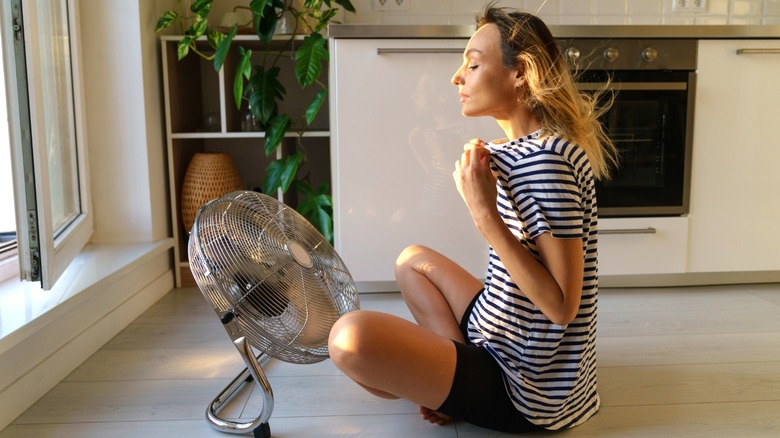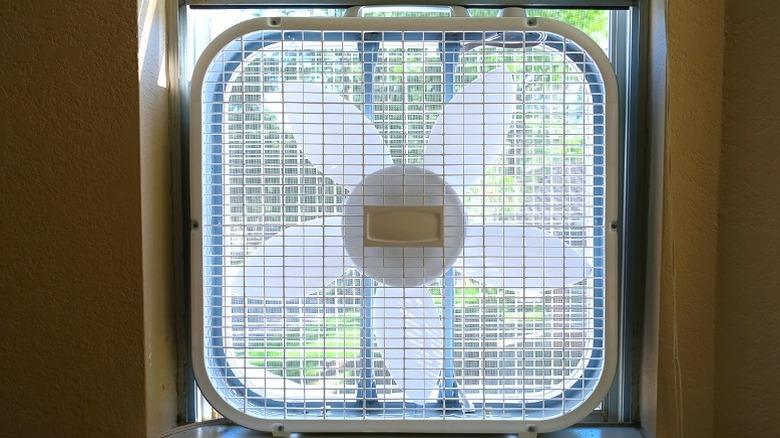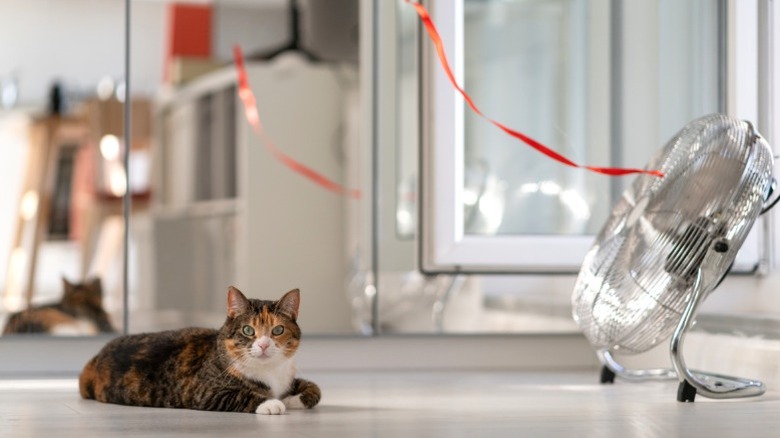The Biggest Mistakes You're Making When Cooling Down Your Room With A Fan
For something we rely on so heavily to get us through the hot summer months, air conditioners sure have a way of hitting us where it hurts. It's bad enough that A/Cs ironically contribute to a warmer planet (accounting for roughly 3% of carbon emissions), but the cost of using it has a clear impact with every monthly bill. Running the A/C adds over $400 to the average annual power bill, more than enough to leave us scrambling for alternative solutions. So why not dust off the electric fan? Alongside the lower cost of cooling, fans improve indoor air quality and circulation, letting you bump your thermostat up a few degrees without sacrificing comfort. If you know how to strategically use your fans and avoid common pitfalls, the difference they make can be profound!
One of the first and worst mistakes you can make when cooling your room with a fan is picking the wrong size. For ceiling fans, sizes up to a 36-inch diameter may work for smaller rooms, but a large room over 400 square feet would need a fan at least 50 inches wide to adequately circulate air within it. It's a similar story if you're using a free-standing fan. After that, you need to worry about which way the fan is pointing, which will change according to the seasons. In the winter, turning a ceiling fan clockwise is ideal to pass warm air back into the room, but if you forget to switch it back to counterclockwise rotation in the spring, you'll lose that downward wind chill effect that proves helps keep your home cool in the summer.
Major mistakes you're making when using the fan
Fan blade direction isn't the only strategic way of looking at using fans to cool the room. What many forget is that a fan isn't an air conditioner, so you have to work with the air temperature and airflow to make them more effective. The best way to use them is as an intake and exhaust when the air outside is cooler than inside. Fans can pull cool air in and push warm air out, but they won't actually lower the temperature of a room. Don't make the mistake of thinking a fan can offer relief in any hot situation. At high temperatures over 95 degrees Fahrenheit, a fan can actually be counterproductive, particularly when the air is dry, as it won't provide any convective or evaporative cooling.
Since heat is such a crucial consideration, you have to look at which direction you create a cross-breeze to move air through the home. Setting up a fan at random is a common mistake that many don't think of as overly consequential. You don't want to pull in hot air. If you set up a fan to draw air into a window, it should be on a shady, cool side of the house (often the north-facing side), ideally with the wind blowing toward it. Heat rises, so the window fans that are exhausting the hot air should be on the opposite side of the house on the upper floors and in tall windows.
Tips and tricks to cool the room more effectively with a fan
Since fans are best at simulating a cross breeze, their proper use goes hand in hand with opening windows the right way to cool down the home. Open windows on opposite ends of the house, setting a fan on one side to blow in and one on the other end to blow out. Window fans work well, or you can use floor-standing fans and direct them at or away from the window. Play with the placement to optimize airflow. You may find better results by placing the outward-blowing fan a couple feet from the window.
If you have multiple fans, one of the smartest ideas to cool down the room is to have them guide the air through the house. If you open a lower-level window to draw in air and a second-floor window to expel it, set up fans that you can tilt up and push the air along the path. When using standalone fans, tilting them upward is generally a good idea because it circulates cooler floor air to make the entire room more comfortable.
For quick results, you can also pair your fan with simple hacks. Put a bowl of ice in front of a fan, for instance, and it will circulate the cooled air. The most critical method, though, is paying attention to the temperature outside and using fans accordingly. Open the windows and crank on the fans to move the air when the outside air is cool. And when the day moves on and heats up, shut the windows. Use individual fans alongside the A/C to move the air, reduce hot spots, and maintain optimal comfort all day long.


